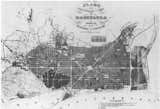Search “98年毕业的大专怎样进行学历认证专做假证,文凭,成绩单+薇:674150256”
Civil engineer Ildefons Cerda designed a plan for the "Eixample," Catalan for "extension." The government approved his scheme, shown here, in 1856. Cerda dictated a regular street grid with city blocks measuring 371 feet by 371 feet, buildings with a depth of no more than 78 feet on each side, a central green space within each block, and streets measuring 65 to 98 feet wide—the optimum dimensions to ensure a good quality of life—maximum daylight, strong air circulation, ample living space. One of Barcelona's most-unique urban elements is the octagonal street intersection and city block shape. Cerdas did that to make it easier to turn corners and to provide more public space on the sidewalks. His design was so forward-thinking it remained in place as the city's official plan until 1953.
